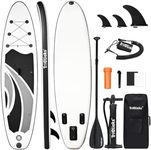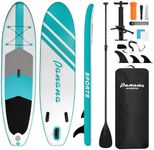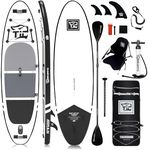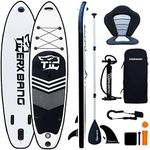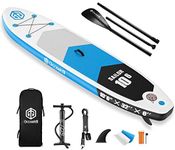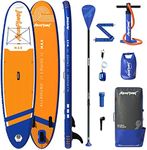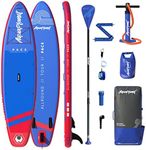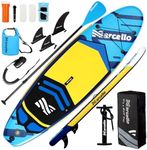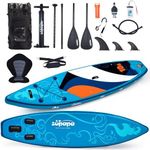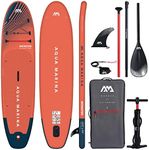Buying Guide for the Best Inflatable Paddle Boards For Beginners
Choosing the right inflatable paddle board for beginners can be a fun and rewarding experience. Paddle boarding is a great way to enjoy the water, get some exercise, and explore new places. When selecting a paddle board, it's important to consider several key specifications to ensure you get the best fit for your needs. These specs will help you understand the board's performance, stability, and suitability for different activities. Let's dive into the key specs and what they mean for you.Board LengthBoard length is an important factor in determining the stability and maneuverability of the paddle board. For beginners, a longer board (10-12 feet) is generally more stable and easier to balance on, making it ideal for learning and casual paddling. Shorter boards (under 10 feet) are more maneuverable and better suited for more experienced paddlers or those looking to surf. If you're new to paddle boarding, opt for a longer board to help you get comfortable on the water.
Board WidthBoard width affects the stability and balance of the paddle board. Wider boards (30-34 inches) provide more stability, making them ideal for beginners who need extra support while learning to balance. Narrower boards (under 30 inches) are faster and more agile but require better balance and skill. As a beginner, choosing a wider board will help you feel more secure and confident on the water.
Board ThicknessBoard thickness impacts the buoyancy and rigidity of the paddle board. Thicker boards (5-6 inches) offer better buoyancy and stability, which is beneficial for beginners. Thinner boards (under 5 inches) may be less stable and more prone to bending. For a beginner, a thicker board will provide a more stable and comfortable experience, especially if you plan to paddle in calm waters.
Board VolumeBoard volume is a measure of the board's capacity to support weight. Higher volume boards can support more weight and provide better stability, making them suitable for beginners. Volume is typically measured in liters, and for beginners, a board with a volume of 200-300 liters is recommended. This ensures the board can comfortably support your weight and any additional gear you might bring along.
Material and ConstructionThe material and construction of the paddle board affect its durability and performance. Inflatable paddle boards are usually made from PVC with drop-stitch construction, which provides a good balance of durability and rigidity. Look for boards with reinforced seams and high-quality materials to ensure they can withstand regular use and minor impacts. As a beginner, choosing a well-constructed board will give you peace of mind and a better overall experience.
Fin SetupThe fin setup on a paddle board influences its tracking and stability. Most beginner boards come with a single large center fin or a three-fin setup (one large center fin and two smaller side fins). A single fin setup is easier to use and provides good stability, while a three-fin setup offers better tracking and maneuverability. For beginners, a single fin or three-fin setup will work well, but the single fin is often simpler to manage.
Weight CapacityWeight capacity is the maximum weight the paddle board can support while maintaining performance and stability. It's important to choose a board with a weight capacity that exceeds your body weight and any additional gear you plan to carry. For beginners, look for boards with a weight capacity of at least 250 pounds to ensure a stable and enjoyable experience on the water.
AccessoriesMany inflatable paddle boards come with accessories such as a paddle, pump, leash, and carrying bag. These accessories can enhance your paddle boarding experience and make it easier to transport and use your board. As a beginner, look for a package that includes these essential accessories to get started without needing to purchase additional items separately.
